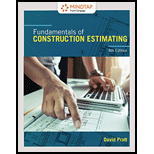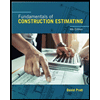
FUND.OF CONSTRUCTION...-MINDTAP(2 TERM)
4th Edition
ISBN: 9781337552851
Author: Pratt
Publisher: CENGAGE L
expand_more
expand_more
format_list_bulleted
Question
Chapter 4, Problem 6RQ
To determine
The description of the use of digitizers and explanation of the difference between the two main types of digitizers.
Expert Solution & Answer
Want to see the full answer?
Check out a sample textbook solution
Students have asked these similar questions
Question 6:
Chlorine is widely used to purify municipal water supplies and to treat swimming pool
waters. Suppose that the volume of a particular sample of Cl₂ gas is 8.70 L at 895 torr
and 24°C.
(a) How many grams of Cl₂ are in the sample?
⚫ Atomic mass of CI = 35.453 g/mol
• Molar mass of Cl₂ = 2 x 35.453 = 70.906 g/mol
Solution:
Use the Ideal Gas Law:
Step 1: Convert Given Values
• Pressure: P = 895 torr → atm
PV=
= nRT
1
P = 895 ×
= 1.1789 atm
760
•
Temperature: Convert to Kelvin:
T24273.15 = 297.15 K
• Gas constant: R = 0.0821 L atm/mol. K
Volume: V = 8.70 L
Step 2: Solve for n
.
PV
n =
RT
n =
(1.1789)(8.70)
(0.0821)(297.15)
10.25
n =
= 0.420 mol
24.405
Step 3: Calculate Mass of Cl₂
Final Answer: 29.78 g of Cl₂.
mass nx M
mass=
(0.420)(70.906)
mass=
29.78 g
Please solve the highlighted question.
1. Design a PVC sanitary sewer collection system for the Village of Waffle (Figure P-17-24 B, shown below) by
preparing a sewer design table similar to that shown in Example 19-2 and a profile drawing similar
to Figure 19-13b B. You only need to show the calculations for the pipes running along Bacon Road and
Eggs Road, starting at point F and ending at Point B in the figure below. Your design should comply with the
requirements specified in Chapter 30 of the 10 States Standards for Wastewater. Use the following
assumptions:
0
о
о
Average daily flow rate is the same as average daily water demand, 9.2 m³/hr
Peaking factor for peak dry weather flow is 6.2
Peak wet weather flow is equal to the peak dry weather flow plus an assumption for infiltration and inflow
at 40 L/d-mm-km of pipe
DODO
on Ro
450 m
28 m
D.
150 m
Apartments
D
400 m
D
200 m
B
250 m
0
Dogs Road
ROOD625 m
-120 m
Syrup River
120 m
100-Year flood
Point
Elevation
Tank
137.0 m
A
130.0 m
B
122.0 m
C
122.3 m
D
122.6 m
A
D
300 m…
Chapter 4 Solutions
FUND.OF CONSTRUCTION...-MINDTAP(2 TERM)
Knowledge Booster
Similar questions
- Need helparrow_forward2. Design a circular clarifier for a flow rate of 34,560 m³/d. Use a design overflow rate of 30 m³/d-m². Assume the clarifier has a center feed and a side water depth of 4.3 m. Use a feedwell detention time of 20 min. Provide the following information to support your design: • Diameter of the clarifier • Diameter and depth of the feedwell . Check the flow velocity across the sludge zone • Calculate the weir loading ratearrow_forwardName: Course: Mechanics of Deformable Bodies Investigation and Design of Axially Loaded Structural Members Date: Term: A. Objective 1. To be able to determine internal axial load on structural members 2. To be able to design structural members with axial internal reactions B. General Instruction 1. Write your solution legibly in separate sheets of clean bond paper. 2. Box your final answer in your solution. C. Situation A truss structure is an assembly of straight structural members that form triangular panels. The assembly of triangular panels makes the truss establish a rigid configuration. In a truss structure, connections are theoretically assumed to act as smooth pin; therefore, it does not resist any moment or bending. Due to this magnificent behavior, truss members only resist axial forces in the design phase that could either be compressive or tensile. Presented in the figure is a truss that is a component of a roof framing system to be constructed at the University Lucena City…arrow_forward
- 1- A two-lane highway (two 3.6 m lanes) has a posted speed limit of 100 km/h and, on one section, has both horizontal and vertical curves, as shown in the figure below. A recent daytime crash (driver traveling westbound and striking a stationary roadway object) resulted in a fatality and a lawsuit alleging that the 100 km/h posted speed limit is an unsafe speed for the curves in question and was a major cause of the crash. Evaluate and comment on the roadway design (after Mannering and Washburn). Plan view (horizontal alignment) PC Station 4+90 Profile view (vertical alignment) e = 8.0% 100 m Sight obstruction 50° G₁ = -2.0% PVC Station 4+30 T PVI PVT Station 6+80 PT N Station 10+00 G₂ = +4.0%arrow_forwardExisting Filter Design Parameters at 22.5 MGD: A) # of Filters: 5 B) #Bays per Filter: 1 C) Bay Surface Dimensions (L X W X D): (40.5 ft. X 13 ft. X 11.5 ft.) D) Surface Area per Filter: 526.5 ft^2 E) Total Filtration Area: 2,633 ft^2 F) Hydraulic Loading Rate: 6 gpm/sf (w/ all filters in service) G) Filtration Capacity at HLR: 22.7 MGD H) Filter Media: 1) Anthracite: 20 in. depth, 1.00 mm Effective Size 2) Sand: 9 in. depth, 0.50 mm Effective Size 1) L/d Ratio (depth of media/effective size): 965 J) Backwash Pumps: 15 MGD (two pumps) K) Backwash water for the filters is provided from the high service pump station through a 24-inch backwash water L) Air Wash Blowers: 1) Number: 2 Hoffman Centrifugal Model 38406A, 125 hp 2) Capacity: 3,100 scfm (standard cubic ft/^2) 3) Air Scour Rate: 5.90 scfm/ft^2 Deliverables: 1) Determine if the existing filtration system is sufficient to accommodate the projected future capacity. A) Current Capacity: 22.5 MGD B) Future Capacity: 34.5 MGD for…arrow_forwardPart 1: True or False. Indicate whether the following statements are True (T) or False (F) by encircling the letter that corresponds to your answer. 1. (T/F) Residual soils are formed by the weathering of rocks in place. 2. (T/F) The Standard Penetration Test (SPT) provides a disturbed soil sample. 3. (T/F) The groundwater table has no effect on the interpretation of soil exploration data. 4. (T/F) Geophysical methods are always more accurate than direct soil sampling methods. 5. (T/F) The N-value in the SPT is the number of blows required to drive the sampler the first 150 mm. Part 2: Multiple choice. Choose the best answer for each question. 1. Which of the following is NOT a transported soil deposit? a) Alluvial b) Glacial c) Residual d) Aeolian 2. What is the primary purpose of subsurface exploration? a) To determine the depth of bedrock b) To identify soil types and their properties 3. Which test provides a continuous profile of soil a) Standard Penetration Test (SPT) b) Cone…arrow_forward
- Determin the shear and moment in teh beam as a function of x where 2m<x<4m.arrow_forwardEncuentra las fuerzas internas de todos los elementos en las siguientes armaduras por el método de nodosarrow_forwardGiven a side slope of 2:1, a road width of 10 m and cross-sectional area of 36.4 sq m, for the following cross-sectional notes: 9.8..........0...........x2 y1..........y..........1.2 Determine the value of y.arrow_forward
- From station A with center height for 1.4m in fill, the ground makes a uniform slope of 5% to station B whose center height is 2.8 m in cut. Assuming both sections to be level sections having a width of roadway of 14 m and a side slope of 2:1 for both cut and fill, compute the cross-sectional area of fill 48 m from station A. Distance from station A to station B is 60 m.arrow_forwardFrom station 10+100 with center heights of 2 m in fill, the ground line makes a uniform slope of 4.8% to station 10+150 whose center heights is 1.2 m in cut. 1. Determine the slope of a new roadway to be constructed. 2. Determine the distance from station 10+150, will the excavation extend. 3. Determine the area of fill 10 m from 10+100 if the width of roadway is 8 m and the side slope is 1:2.arrow_forwardFunding Plan How much funds required to reach to the next level of the venture? • ? How much have been bootstrapped? If not, why? • ? How much can be bootstrapped? • ? How much external funding required? If not, why? • ? Funds utilization strategy (Details) • ? • ? • ? • ? • ? • ? • • ? ? ? ? ? Place your logo herearrow_forward
arrow_back_ios
SEE MORE QUESTIONS
arrow_forward_ios
Recommended textbooks for you
 Fundamentals Of Construction EstimatingCivil EngineeringISBN:9781337399395Author:Pratt, David J.Publisher:Cengage,
Fundamentals Of Construction EstimatingCivil EngineeringISBN:9781337399395Author:Pratt, David J.Publisher:Cengage, Architectural Drafting and Design (MindTap Course...Civil EngineeringISBN:9781285165738Author:Alan Jefferis, David A. Madsen, David P. MadsenPublisher:Cengage Learning
Architectural Drafting and Design (MindTap Course...Civil EngineeringISBN:9781285165738Author:Alan Jefferis, David A. Madsen, David P. MadsenPublisher:Cengage Learning Engineering Fundamentals: An Introduction to Engi...Civil EngineeringISBN:9781305084766Author:Saeed MoaveniPublisher:Cengage Learning
Engineering Fundamentals: An Introduction to Engi...Civil EngineeringISBN:9781305084766Author:Saeed MoaveniPublisher:Cengage Learning

Fundamentals Of Construction Estimating
Civil Engineering
ISBN:9781337399395
Author:Pratt, David J.
Publisher:Cengage,

Architectural Drafting and Design (MindTap Course...
Civil Engineering
ISBN:9781285165738
Author:Alan Jefferis, David A. Madsen, David P. Madsen
Publisher:Cengage Learning

Engineering Fundamentals: An Introduction to Engi...
Civil Engineering
ISBN:9781305084766
Author:Saeed Moaveni
Publisher:Cengage Learning